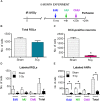Radiation Induces Distinct Changes in Defined Subpopulations of Neural Stem and Progenitor Cells in the Adult Hippocampus
- PMID: 30686979
- PMCID: PMC6333747
- DOI: 10.3389/fnins.2018.01013
Radiation Induces Distinct Changes in Defined Subpopulations of Neural Stem and Progenitor Cells in the Adult Hippocampus
Abstract
While irradiation can effectively treat brain tumors, this therapy also causes cognitive impairments, some of which may stem from the disruption of hippocampal neurogenesis. To study how radiation affects neurogenesis, we combine phenotyping of subpopulations of hippocampal neural stem and progenitor cells with double- and triple S-phase labeling paradigms. Using this approach, we reveal new features of division, survival, and differentiation of neural stem and progenitor cells after exposure to gamma radiation. We show that dividing neural stem cells, while susceptible to damage induced by gamma rays, are less vulnerable than their rapidly amplifying progeny. We also show that dividing stem and progenitor cells that survive irradiation are suppressed in their ability to replicate 0.5-1 day after the radiation exposure. Suppression of division is also observed for cells that entered the cell cycle after irradiation or were not in the S phase at the time of exposure. Determining the longer term effects of irradiation, we found that 2 months after exposure, radiation-induced suppression of division is partially relieved for both stem and progenitor cells, without evidence for compensatory symmetric divisions as a means to restore the normal level of neurogenesis. By that time, most mature young neurons, born 2-4 weeks after the irradiation, still bear the consequences of radiation exposure, unlike younger neurons undergoing early stages of differentiation without overt signs of deficient maturation. Later, 6 months after an exposure to 5 Gy, cell proliferation and neurogenesis are further impaired, though neural stem cells are still available in the niche, and their pool is preserved. Our results indicate that various subpopulations of stem and progenitor cells in the adult hippocampus have different susceptibility to gamma radiation, and that neurogenesis, even after a temporary restoration, is impaired in the long term after exposure to gamma rays. Our study provides a framework for investigating critical issues of neural stem cell maintenance, aging, interaction with their microenvironment, and post-irradiation therapy.
Keywords: adult neurogenesis; gamma irradiation; nucleotide labeling; quiescent progenitors; stem cells.
Figures








Similar articles
-
Suppressed neurogenesis without cognitive deficits: effects of fast neutron irradiation in mice.Neuroreport. 2019 May 22;30(8):538-543. doi: 10.1097/WNR.0000000000001237. Neuroreport. 2019. PMID: 30950935
-
Running rescues defective adult neurogenesis by shortening the length of the cell cycle of neural stem and progenitor cells.Stem Cells. 2014 Jul;32(7):1968-82. doi: 10.1002/stem.1679. Stem Cells. 2014. PMID: 24604711
-
DNA damage accumulation during fractionated low-dose radiation compromises hippocampal neurogenesis.Radiother Oncol. 2019 Aug;137:45-54. doi: 10.1016/j.radonc.2019.04.021. Epub 2019 May 4. Radiother Oncol. 2019. PMID: 31063923
-
Radiation injury and neurogenesis.Curr Opin Neurol. 2003 Apr;16(2):129-34. doi: 10.1097/01.wco.0000063772.81810.b7. Curr Opin Neurol. 2003. PMID: 12644738 Review.
-
Postnatal irradiation-induced hippocampal neuropathology, cognitive impairment and aging.Brain Dev. 2017 Apr;39(4):277-293. doi: 10.1016/j.braindev.2016.11.001. Epub 2016 Nov 19. Brain Dev. 2017. PMID: 27876394 Review.
Cited by
-
DNA damage in aging, the stem cell perspective.Hum Genet. 2020 Mar;139(3):309-331. doi: 10.1007/s00439-019-02047-z. Epub 2019 Jul 19. Hum Genet. 2020. PMID: 31324975 Free PMC article. Review.
-
Modes of division and differentiation of neural stem cells.Behav Brain Res. 2019 Nov 18;374:112118. doi: 10.1016/j.bbr.2019.112118. Epub 2019 Jul 29. Behav Brain Res. 2019. PMID: 31369774 Free PMC article. Review.
-
Hyperbaric oxygen therapy attenuates brain radiation-induced cognitive deficits in rats.Int J Med Sci. 2025 Jan 1;22(2):283-297. doi: 10.7150/ijms.104248. eCollection 2025. Int J Med Sci. 2025. PMID: 39781518 Free PMC article.
-
Traumatic Brain Injury Promotes Neurogenesis and Oligodendrogenesis in Subcortical Brain Regions of Mice.Cells. 2025 Jan 10;14(2):92. doi: 10.3390/cells14020092. Cells. 2025. PMID: 39851520 Free PMC article.
-
Co-exposure to inhaled tungsten particles and low-dose gamma rays: neurotoxicological outcome in rats.Sci Rep. 2025 May 26;15(1):18307. doi: 10.1038/s41598-025-02278-3. Sci Rep. 2025. PMID: 40419610 Free PMC article.
References
Grants and funding
LinkOut - more resources
Full Text Sources

